32. Dynamo Close: the story of McClure and
Whitfield
A Davenport history feature, written by Charlie Hulme
Davenport Station home | Index to History pages

For over a century until 2018, passengers on trains approaching Stockport from Davenport might have noticed on the right-hand side two industrial premises: the Woodrow hat works (demolished in 2008 and a story for another day) and the works building emblazoned in large white letters MC CLURE & WHITFIELD - MERSEY DYNAMO WORKS and a grammatically-correct full-stop.
Perhaps passengers alighting at Stockport would get ready when the train passed the sign, and maybe some wondered what a dynamo was - something to do with bicycle lighting perhaps. In later years they might have wondered what Whitfield did wrong to have his name erased.
In 2018, the whole works was erased, to be replaced by a housing development which has happily been christened 'Dynamo Close'. On the same theme, an apartment building on the site is to be known as 'Faraday House', a tribute Michael Faraday (1791 - 1867) who discovered the principle of the Dynamo.
Here we explore the life and times of the works and its two founders.
The Whitfield Family
The ancestry of Robert Brotherton Whitfield can be traced back to his grandfather Robert Whitfield, and his wife Frances, born in Northumberland in 1810. By 1841 they were living in Amble, Northumberland and Robert was working for a railway company as a 'railway [w?]right.' (Amble is a village with a small harbour on the east coast north of Newcastle, terminus of an railway carrying coal traffic to the staithes.) The 1851 census found them in the village of Barlby, near Selby in Yorkshire, with Frances's mother Hannah Rowill, and their children Margaret (Aged 19), Thomas Rowill Whitfield (11), Robert S Whitfield (9) , Mary (7) and John (5). Robert senior worked as a 'Railway Inspector'.
Ten years later, Thomas Rowill Whitfield was livng in lodgings in Monkwearmouth Sunderland and employed as a schoolteacher, along with his younger brother John, listed as a scholar. We then lose sight of him in 1871, although he must have married and left soon afterwards for the Manchester suburb of Cheetham where his first four children were born. In 1881 he appears at 28 Thomas Street, Broughton, Salford, still working as a teacher and married to Cumberland-born Anne Kirtley Whitfield. Present were their children Robert Brotherton Whitfield (age 7, born 10 August 1873), Ethel Annie (5), Florence Mary (4), Harold Edward (4), and Edgar Allan (1). Broughton at the time was a well-off part of Salford, and they had a general servant, although she was a member of the family, Jane Angelina Brotherton, Annie's 19-year-old sister.
In 1891 the family home was 45 Moss Bank, Crumpsall, Manchester, Annie was now also working as a teacher, and Robert was as an 'electrical engineering apprentice'. They had a servant, Ada Haxby, but the other children were not present. Ten years later Robert (aged 27) had completed his apprenticeship, and become a partner in the Dynamo works. He moved with his widowed mother and sister to a semi-detached villa, 'The Poplars' in Brinnington Road, then an up-market part of Stockport.
In 1905, at Brunswick Methodist Chapel, Portwood, Robert Brotherton Whitfield married Charlotte Nelstrop, born 1876, daughter of George Nelstrop, a prominent Stockport citizen who owned the Albion Flour Mill on Lancashire Hill, Stockport. Nelstrop's became an important customer for McClure and Whitfield, when converting their machinery from steam to electricity.
John and Charlotte moved to a semi-detached house in Davenport, at 53 Kennerley Road, backing on to Davenport Park, which no longer exists, replaced by an apartment block, named Cobal Court. A 1923 directory, and 1939 register, by which time Robert had retired, reveal they had moved into Davenport Park, at 'Genistra', 27 Devonshire Park Road. Charlotte died in 1952, Robert in 1957. His son John Nelstrop Whitfield, born in 1907, joined the firm of Piggott and Whitfield, and served as a Director until his death in 1991.
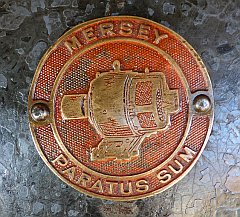
Cameron Pearson
According to a current member of the Whitfield family, in 1847 his great-great grandfather purchased an iron foundry which operated under the name Cameron Pearson. We haven't established where the iron foundry was located, or which of his eight great-great grandfathers is referred to, but presumably it was Robert Whitfield. The foundry was, it seems, later merged into the McClure and Whitfield company. Over a century later, the name Cameron Pearson has been revived as the company name for an estate agency based in Knightsbridge, London, with Robert Whitfield's great-great-grandson as Managing Director.
If anyone know more about the elusive first Cameron Pearson, or if you know more about McClure and Whitfield, please make contact.
The McClure family
Robert McClure, born in Wigan, Lancashire in 1806, was a cotton spinner who came to Stockport to take over Orrell's Mill (also known as Travis Brook MIll), a large spinning mill which had been built by William Fairbairn. By 1851, his son David McClure (born in Wigan in 1830) had joined his father in the firm of McClure and Sons; by that date they were employing 1,276 people and living in a large house, Bower House Fold, with extensive grounds, in Heaton Norris, near the railway line on what is now called Bowerfold Lane. With them in 1851 were David's mother Jane, brother John (aged 18), sister Elizabeth (16) , and three servants.
David McClure (1830 - 1896) who like most cotton magnates became a Justice of the Peace, married Annie Marsh in Wigan in 1861. Their children were Robert Martin McClure, Donald, Annie and David McClure. Robert Martin joined the family textile firm, Donald became a Civil Engineer and Architect. It was their son David McClure, born 1872, who made a career as an electrical engineer.
On 12 December 1907 at the Moravian Church, Shipley, Yorkshire David McClure (junior) married Ruth Gordon Hassé, youngest daughter of Irish-born Alexander B. Hassé of Ingfield, Baildon, Yorkshire, listed as a 'Fine Art publisher, etc'. Ruth's uncle, Evelyn Renatus Hassé, was a Bishop in the Moravian Church and conducted the ceremony. It would be interesting to know how the couple met. They honeymooned in Paris and Switzerland and made their home at 5 Moseley Road, Cheadle Hulme, an ornate five-bedroom semi-detached villa which still stands in in 2020.
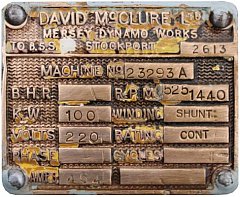
Sources
Ancestry.co.ukGrace's Guide
Old-Maps.co.uk
Stockport Directories
Stockport Planning Database
AEMT Journal, Vol.15 No.1, p.19-24. 'ATB Morley – riding a tidal wave of success'.
ATB Group website.
Mersey Paratus Sum - by 'Tarboat'
Special thanks to Ken Millward for inspiring this article.
Contributions are very welcome:
info@davenportstation.org.uk
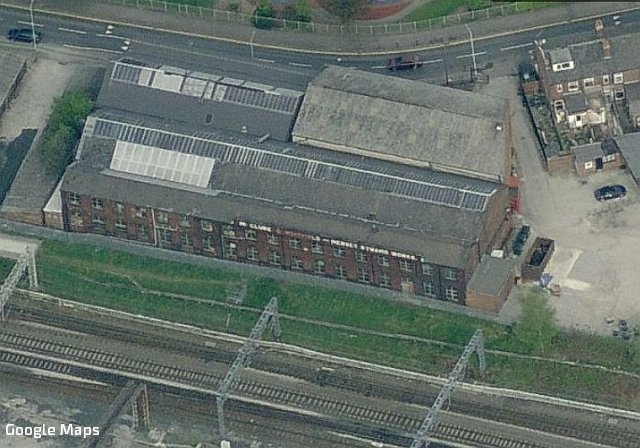
The Mersey Dynamo Works shortly before demolition.
Beginnings
In 1892 Robert Brotherton Whitfield, son of a schoolteacher from Northumberland, joined forces, to manufacture electrical dynamos and motors, with David McClure, whose father (also David) was the owner of Travis Brook cotton-spinning mill in Stockport, Both men had served an apprenticeship as electrical engineers in the Manchester area where they met; where they worked is not known, but a likely choice would be the Salford factory of Mather and Platt, who in 1883 obtained the rights to a dynamo being produced in the USA by the Edison, company, and developed their own improved version.
The two workmates, both in their early twenties, called their company McClure and Whitfield. It appears from directories that they obtained premises in Lower Wellington Mill (also known as Wellington Bridge Mill), which stood on Heaton Lane, Stockport, on the banks of the river Mersey. Perhaps this location inspired the name 'Mersey Dynamo Works'. (The building was demolished in 1973 and replaced by an office block called 'Regent House' which in 2020 houses a Travelodge hotel. Some sources confuse this mill with Wellington Mill, the large building which now houses the Hat Works museum.)
Range Road
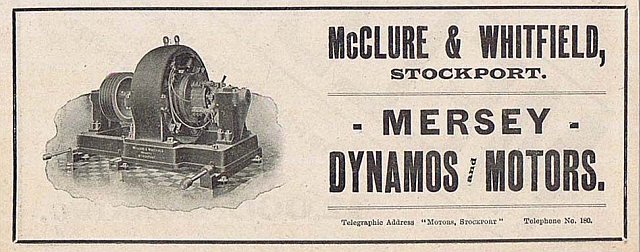
Advertisment from c.1905
The Mersey Dynamo Works was clearly a success, with demand at the time from factories, and even large houses, wanting to use electricity before the days of the National Grid. After a few years the partners were able to commission their own building, on land between the London and North Western Railway company's main line near Stockport Edgeley station, and a newly-created street, Range Road.
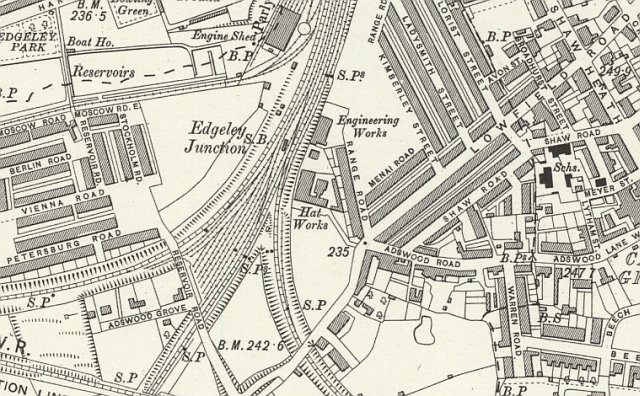
From map evidence the building appears to date from around 1902; it was a close neighbour of Woodrow's hat works, which also proclaimed its name to passing rail travellers, and has also since been replaced by a housing development.
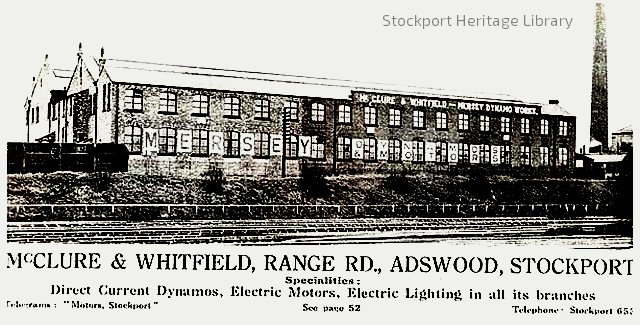
From Stockport Yearbook, 1928.
Sometime between 1910 and 1922 the Dynamo works was extended to the north, on land which was part of the original purchase; this was evident from the off-centre position of the name. Later, it was partially extended again on the side facing the road, and by the 1960s it had been extended further, the final extension having a different profile. The works then occupied occupied all the land available.

View from Range Road in 2018.
Their first product was the dynamo, defined as a machine to create electric current by moving wire coils in a magnetic field, usually by rotational motion driven by steam or other power source. In the time before large power stations, dynamos were in demand for lighting buildings, factories and streets. McClure & Whitfield installed the first electrical lighting on the Thames Embankment in 1897, and large houses made use of their smaller dynamos. The word ‘dynamo’ , is seldom used today, replaced by ‘generator’ or ‘alternator’.
An electric motor uses the same process in reverse to create motion from electricity, and motors were also part of their product range, with applications from powering the projectors for the newly-built Brookfield Hydro cinema in Poynton in 1938, to the steering and drive motors for the Mulberry pontoons for D-Day.
Division
In 1946 the partnership was dissolved; David McClure continued building electric motors and David McClure Ltd, which later incorporated electrical control specialist Vlasto Clark and Wilson.
David McClure died in 1953 but the business continued. The family attempted to keep things running but were bought out by their biggest customer, Thomas Reid & Sons Ltd of Paisley who then owned the Company until in 2007 David McClure Ltd was sold to multinational ATB Morley, who have a UK base in Leeds. The new owners brought in new management, invested in new designs and machinery and transformed the Business.
ATB Morley started life in 1897 as Morley Motors, named for its original site in the town of Morley near Leeds; it's original business was the supply of electric motors for mining applications. in 1905 it opened for business on its current location, in Pudsey, Leeds while keeping the original name. It later added a site in Bradford as a fabrication and heavy machining shop.
In 2004 Morley Motors merged with the ATB Group to form ATB Morley, ATB (Austria Antriebstechnik AG) also has a long history. The ATB Group product range extends from 25W to 25MW and includes standard solutions, customised solutions and design-to-order solutions including complete drive systems for a wide range of applications. In 2020, the group operates from twelve manufacturing bases – in Spielberg, Welzheim, Mönchengladbach, Nordenham, Leeds, Norwich, Cradley Heath, Tarnow, Subotica and Bor – and employs more than 3,500 people.
The Stockport works closed soon after the merger and the building was rented to small businesses - a carpet company was the last tenant - until sold to the house-building developer. A manager from David McClure Ltd serves on the Board of ATB Morley, so a link with the original firm remains. ATB is wholly owned by Wolong Industries of China since 2011.
Piggott and Whitfield
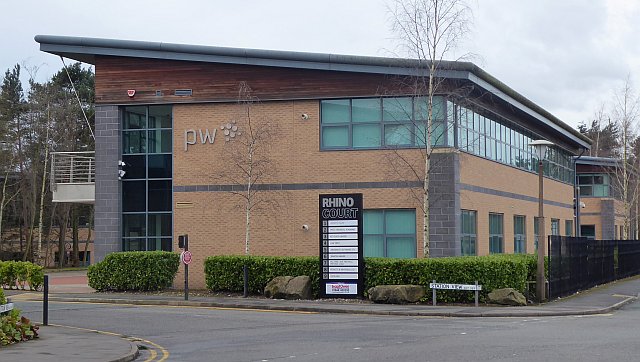
Whitfield and his son John partnered with the works manager of McClure and Whitfield to create an electrical installation business, Piggott & Whitfield Ltd, incorporated in 1947 and initially based on the upper floor of the building, and also premises at 22a Bramhall Lane South, Bramhall and 18 Mill Street, Macclesfield. Robert Brotherton Whitfield died in 1957; but the firm continued under his son John Nelstrop Whitfield, and Piggott and Whitfield (or PW) thrives in 2020, now based in a unit (pictured above) on the former Mirrlees site in Hazel Grove, with Whitfield family members still involved. They have worked on buildings all around country, including Government buildings in Whitehall.
The railway view
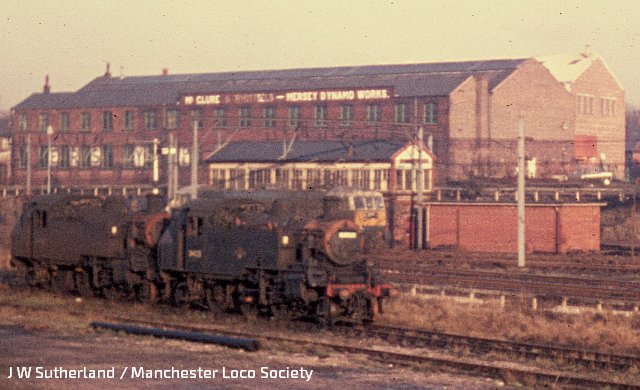
Most photography showing the Dynamo Works from moving trains, as the land opposite was occupied by the Edgeley steam Locomotive sheds, until the last days of steam in the late 60s when the railway management became relaxed about visits. This view, taken by Davenport-based Wallace Sutherland in 1966 shows withdrawn locomotives 84019 and 84025, an electric locomotive passing Edgeley Junction No.1 signalbox. The final extension of the works, looking very new, is on the right.
Dynamo Close
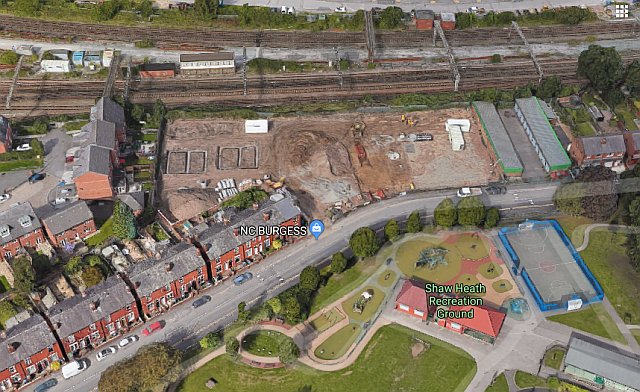
The site cleared and building foundations begin, 2018. Google Maps still marks NC Burgess, the carpet installers. To the left is the housing on the former hat works site.
Planning permission was granted to Nicol Thomas on behalf of Stockport Homes in January 2018 (Ref. DC/066642 on Stockport's planning database) for a residential development of 21 affordable properties comprising five two-bedroom houses, four three-bedroom houses and 12 two-bed apartments within a three- storey block, including associated parking and landscaping works. An interesting comment by the designers is that 'The proposed new dwellings are orientated to make the most of the sun path. Most of the homes will make the most of the sun path with the gardens facing south, south-east and south-west.' The new residents are also well-placed to enjoy the facilities of the recreation ground.

Dynamo Close as seen from Range Road in 2020. The high fence blocks the view of the railway to all but the tallest enthusiast, although the upper floors of the apartment block would seem to have a good view. The Stockport County football ground is in the distance.
Edwin Bowlas, a fellow member of the Manchester Locomotive Society, who shared his memories of the firm, later worked for the railway at Stockport Edgeley locomotive shed and had many tales from the age of steam. He died in spring 2020, and will be greatly missed.
Written by Charlie Hulme, February 2020. Updated March 2023.